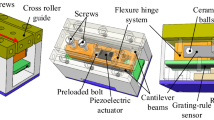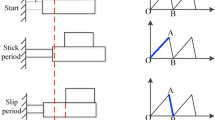Abstract
This paper presents a mechanism for linear movement which could be called threadless screw, in which a roller is pushed toward a rotating plain shaft and rotates with it. The roller moves on a helical path when its axis is not parallel to the axis of the shaft. Therefore, the roller moves in direction of the shaft axis, just as linear movement of a nut on a screw. The lead of this mechanism is not only a function of diameter of the shaft, but also the angle between axes of the roller and the shaft which gives the possibility to change the lead continuously from very fine to very rough leads. On the other hand the accuracy of this mechanism depends on the accuracy of a plain cylindrical surface which can be fabricated very accurately compared with the threads of a screw. Two configurations of this mechanism were designed and fabricated to verify the idea. Coarse and fine positioning speeds are 10 and 0.1 mm/sec over an effective range of 200 mm, respectively. The experimental results show that the fast positioning over wide range of movement with resolution of 10 nm is possible by this mechanism. Further investigation shows that applying thrust loads have considerable effect on the lead of the mechanism.











Similar content being viewed by others
References
Morita, T., Yoshida, R., Okamoto, Y., & Higuchi, T. (2002). Three DOF parallel link mechanism utilizing smooth impact drive mechanism. Precision Engineering, 26(3), 289–295.
Chen, Y. C., Chen, Y. P., & Lee, J. Y. (2012). Experimental results of a wafer positioning system using machine vision after system calibration. In Proceedings of IEEE SICE annual conference (SICE) (pp. 1014–1017).
Yang, B., Meng, G., Feng, Z. Q., & Yang, D. (2011). Giant magnetostrictive clamping mechanism for heavy-load and precise positioning linear inchworm motors. Mechatronics, 21(1), 92–99.
Cocola, L., Fedel, M., Mocellin, M., Casarin, R., & Poletto, L. (2013). Optical device for the improvement of positioning accuracy in large machine tools. In SPIE optical metrology 2013 (pp. 87882D–87882D). International Society for Optics and Photonics.
Smith, A. R., Gwo, S., & Shih, C. K. (1994). A new high-resolution two-dimensional micropositioning device for scanning probe microscopy applications. Review of Scientific Instruments, 65(10), 3216–3219.
Fischer, G. S., Iordachita, I., Csoma, C., Tokuda, J., DiMaio, S. P., Tempany, C. M., et al. (2008). MRI-compatible pneumatic robot for transperineal prostate needle placement. IEEE/ASME Transactions on Mechatronics, 13(3), 295–305.
Rosowski, J. J., Dobrev, I., Khaleghi, M., Lu, W., Cheng, J. T., Harrington, E., et al. (2012). Measurements of three-dimensional shape and sound-induced motion of the chinchilla tympanic membrane. Hearing Research, 301, 44–52.
Li, J., Liu, Y., Sun, L., & Jie, D. (2005). Mechanism and control of linear positioning for IC wire bonders. In IEEE 2005 6th international conference on electronic packaging technology, (pp. 171–174).
Higuchi, T., Yamagata, Y., Furutani, K., & Kudoh, K. (1990). Precise positioning mechanism utilizing rapid deformations of piezoelectric elements. In Micro electro mechanical systems, 1990. IEEE proceedings, an investigation of micro structures, sensors, actuators, machines and robots. (pp. 222–226).
Li, Y., & Xu, Q. (2011). A novel piezoactuated XY stage with parallel, decoupled, and stacked flexure structure for micro-/nanopositioning. IEEE Transactions on Industrial Electronics, 58(8), 3601–3615.
Zhu, C., Chu, X., Yuan, S., Zhong, Z., Zhao, Y., & Gao, S. (2016). Development of an ultrasonic linear motor with ultra-positioning capability and four driving feet. Ultrasonics, 72, 66–72.
Li, J., Huang, H., & Morita, T. (2019). Stepping piezoelectric actuators with large working stroke for nano-positioning systems: a review. Sensors and Actuators A: Physical, 292, 39–51.
Li, J., Zhao, H., Qu, X., Qu, H., Zhou, X., Fan, Z., et al. (2015). Development of a compact 2-DOF precision piezoelectric positioning platform based on inchworm principle. Sensors and Actuators A: Physical, 222, 87–95.
Cusin, P., Sawai, T., & Konishi, S. (2000). Compact and precise positioner based on the inchworm principle. Journal of Micromechanics and Microengineering, 10(4), 516.
Fukada, S., Nishimura, K., & Matsuda, T. (2011). Modelling and control of flexure mechanism driven by electromagnetic linear motors for ultraprecise continuous path positioning over a one-millimetre stroke. International Journal of Automation Technology, 5(6), 809–822.
Xiao, S., & Li, Y. (2013). Optimal design, fabrication and control of an XY micro-positioning stage driven by electromagnetic actuators. IEEE Transactions on Industrial Electronics, 60, 4613–4626.
Wang, N., Zhang, Z., Zhang, X., & Cui, C. (2018). Optimization of a 2-DOF micro-positioning stage using corrugated flexure units. Mechanism and Machine Theory, 121, 683–696.
Maslan, M. N., Kokumai, H., & Sato, K. (2017). Development and precise positioning control of a thin and compact linear switched reluctance motor. Precision Engineering, 48, 265–278.
Yu, C., Wang, C., Deng, H., He, T., & Mao, P. (2016). Hysteresis nonlinearity modeling and position control for a precision positioning stage based on a giant magnetostrictive actuator. RSC Advances, 6(64), 59468–59476.
Lin, C. J., & Yang, S. R. (2006). Precise positioning of piezo-actuated stages using hysteresis-observer based control. Mechatronics, 16(7), 417–426.
Tan, K. K., Lee, T. H., & Zhou, H. X. (2001). Micro-positioning of linear-piezoelectric motors based on a learning nonlinear PID controller. IEEE/ASME Transactions on Mechatronics, 6(4), 428–436.
Okyay, A., Erkorkmaz, K., & Khamesee, M. B. (2018). Mechatronic design, actuator optimization, and control of a long stroke linear nano-positioner. Precision Engineering, 52, 308–322.
Hojjat, Y., & Mahdi Agheli, M. (2009). A comprehensive study on capabilities and limitations of roller–screw with emphasis on slip tendency. Mechanism and Machine Theory, 44(10), 1887–1899.
Sandu, S., Biboulet, N., Nelias, D., & Abevi, F. (2018). An efficient method for analyzing the roller screw thread geometry. Mechanism and Machine Theory, 126, 243–264.
Ma, S., Cai, W., Wu, L., Liu, G., & Peng, C. (2019). Modelling of transmission accuracy of a planetary roller screw mechanism considering errors and elastic deformations. Mechanism and Machine Theory, 134, 151–168.
https://www.ks-kurim.com/additional-assortment/threadless-ball-screws/
Norton, R. L. (2010). Machine design: an integrated approach (4th ed.). London: Pearson.
Author information
Authors and Affiliations
Corresponding author
Additional information
Publisher's Note
Springer Nature remains neutral with regard to jurisdictional claims in published maps and institutional affiliations.
Rights and permissions
About this article
Cite this article
Hojjat, Y., Shirkosh, M. Application of Threadless Screw to Precise Linear Positioning. Int. J. Precis. Eng. Manuf. 22, 355–364 (2021). https://doi.org/10.1007/s12541-020-00407-8
Received:
Revised:
Accepted:
Published:
Issue Date:
DOI: https://doi.org/10.1007/s12541-020-00407-8




